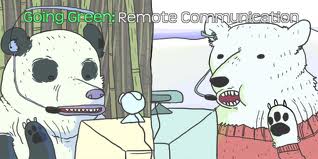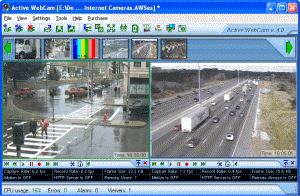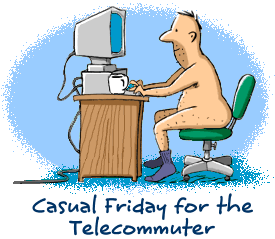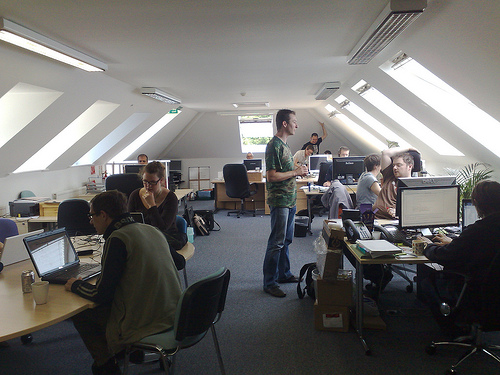When working remotely, it’s important to update people. Since you’re not in an office and people cant’ see what you’re doing, you have to let people know that you are in fact, working on the assigned task.
While communication is important, where is the line between communicating what needs to be communicated and over-communicating? And how do you draw that line?
Not Everybody Needs to Know Every Little Thing
When working with a team, you don’t need to update the entire team and every little thing. Before you send an update, think about who is involved and who needs to know. Send it only to those people. If you’re having Task X done on Thursday instead of Wednesday doesn’t affect Bob in anyway shape or form, there’s no reason to email Bob, is there?

Send Regular Status Updates-When Needed
Status updates are good thing, until you start to over-do them. When you start on a project, discuss with your client, your boss, or your team how often they would like updates. This sets clear update expectations and helps to prevent over or under updating.
If you didn’t start off setting expectations, and how you’re updating is working, then by all means, keep doing what you’re doing. However, if you find that it’s not working-maybe one of you is constantly trying to get in contact with the other-it might be a good time to establish those parameters now. Better late than never.
Make Use of the Proper Communication Channels
As we mentioned before using the appropriate form of communication is important. If you have a question about a task assigned to you through a project management system, comment directly on the task in the system. Using the proper communication channels ensures that you get a timely response as efficiently as possible.
Know When to Pick Up the Phone
Ever end up in one of those email threads that could have been handeled through a 10 minute phone call, but instead turned into 30 emails? Recognize when emails are heading that way and pick up the phone, hop on Skype, or send an IM. Sometimes you just need real-time communication.
How do you update without over-updating?
Read More...

Not too long ago, before it (thankfully) fell out of fashion, bottled water was all the rage. It was common knowledge that the more you paid, the better it was. A few years ago, you couldn’t go 5 minutes without catching a glimpse of someone with a brightly colored Nalgene bottle. These days, everyone has a BPA-free aluminum water bottle or four, perfect for filling at the tap, which is now trendy. Whatever the container, the thing that made all these accessories valuable was what went in them: Water.
To which I say, “not thirsty.”
I’m something of an anomaly, apparently: I don’t like water.
I mean, I love it when I’ve been exercising and my throat is dry and the water is cold. Times like that, it’s the only thing I want to drink. But keeping a bottle with me at all times? No. Grabbing a glass as I pass through the kitchen? Why, when there are tastier options a like soda or wine a at hand?
I may be weird, but I’m not unique. I stumbled into a conversation with a friend a year or so ago in which he was complaining about not liking water. It was exciting to find someone who shared my antipathy towards perhaps the most precious natural resource. Water’s just soa¦ boring, we agreed.
For whatever reason, I just don’t like the taste (and yes, I see the irony of that statement). Water is healthy, of course, but I figured calorie-free diet soda was OK. So I was dismayed to see this article about a study that suggests diet soda might not be OK after all.
The study found a link between diet soda and a larger waist size. And by “larger,” we’re talking 70 percent greater than people who didn’t drink diet soda. It’s even worse news for people who had two or more diet sodas a day: Their waists were 500 percent bigger.
The research also delved into health consequences of artificial sweeteners, but I’m a vain person and the waist-size data grabbed my attention more a maybe 500 percent more a than the health stuff. Yowza.
So I’m embarking on a quest to find alternatives to both water and diet soda. Most juice has a high amount of sugar; milk has lots of calories; and alcoholic beverages are clearly not suitable for on-the-job consumption (not my job, anyway). I was intrigued to read about the backstory of Hint, which was created by a woman who was addicted to Diet Coke but didn’t like water (perhaps we were separated at birth). It’s not available in my city yet, but I plan to track it down and test it out. I’m also planning to do some of my own flavored-water creations.
If you’ve got wet-your-whistle suggestions, fire away. I promise to give them a try, at least until someone says they’ll make my waist way bigger than my aqua-chugging friends.
Read More...
Last week I made a comment on twitter about how I did not want to hire a candidate without previously have a Github account. I got some backlash more or less calling me a fan boy of Github. While I am a fan boy of Github, that was not the reasoning behind my comment.

If you have ever read a programmera's resume you know it is a big listing of every programing language they have ever looked at. All languages are the same right? Once you know one you know them all right? I call bullshit on this. Yes, once you know some CS fundamentals jumping into a new language is easier. You do not need to go back to college or anything. You can generally figure it out - but you cannot figure it out overnight. Just because you are considered a senior programmer in one language it does not make you a senior programmer in another language. As a small business we can not afford to hire someone that is going to need ramping up time. We need someone that can hit the ground running. We need someone that is going to produce high quality code, quickly.
So when looking at some one’s Github account I can quickly see what language makes them high. I can see what technologies they pursue in their own time. You dona't publish code on Github unless you are at least somewhat proud of it. Going to anyone’s Github account shows you within seconds what language is their primary focus. I am only interested in hiring people that share the same primary focuses we have. When hiring I want the best of the best in the field we are looking for, not someone who can alearn to be the besta or who is the best at something else.

Lastly, the technologies we use have all made Github their official home. The leaders and maintainers building these technologies have made Github their official hangout. If you are not part of this community it is a good indication to me that you are not truly passionate about your programming craft, (or at least the craft we are looking for). If you are truly passionate about skiing you do not live in Florida do you?
Generally, I want to hire people who have a natural fascination with the technologies we use. In programming passion and fascination are much bigger motivators than a paycheck. Not having a Github account in my world says to me you are just looking for a paycheck.
Read More...
 I had a Firefox browser open the other day when a coworker walked into my office. I jumped, simultaneously clicking a different browser tab to hide what I’d been viewing.
I had a Firefox browser open the other day when a coworker walked into my office. I jumped, simultaneously clicking a different browser tab to hide what I’d been viewing.
“What’s up?” my colleague asked.
“Not much,” I said, my guilty mouse finger searching for a work-related document to maximize on the screen.
She’d caught me in a distracted moment. It happens more often than I’d like to admit a one second I’m looking at something absolutely work-related, and then a few clicks later, I’m somewhere else entirely. My computer screen, unfortunately, faces the door to my office, so the scene described above isn’t exactly rare. I think my coworkers suspect.
My confession: I like to look at webcams. Especially when there’s lots of action: storms, sunrises, wildlife.
This confession either makes me boring as hell or a bona fide freak. But the truth is, if there’s a camera is monitoring scenery or traffic, I want to see it.
I think this, er, hobby, started after a visit to Glacier National Park a few summers ago. Glacier has an impressive array of webcams that can help you monitor the weather for your trip, or help you prolong your visit after you’ve returned home. The site quickly became a fixture of my daily routine. Leaves turned color; snow fell; water froze. It was beautiful.
I started branching out. Glacier leads the pack, but there are other national parks with cams, and I checked on those. My local coffee shop has a webcam so you can check the line. I used to live in upstate New York, and in the fall I wistfully searched out foliage cams. Any car ride over a mountain pass was preceded by a check of the ODOT site.
Then I found the mother lode, the jackpot, the URL that was to a webcam aficionado like me what Kulminator is to a beer lover: The FAA aviation cameras of Alaska.
These are traffic cams, but not for street traffic. They’re meant to show pilots the conditions at Alaska’s numerous small airports. Because of that, they don’t record freeways or interchanges, but mountain passes and tundras. Each location has multiple cameras pointing different directions. And the best part: You can watch time-lapse sequences. So, for instance, you can see the sun rise over Anchorage, the moon set over Kasigluk and the tides change at Hawk Inlet. I continually hope to see wildlife wander into view, maybe caribou in Tuntutuliak or bear in Valdez.
If I sound like I know where these places are in relation to each other, or any other point north of British Columbia, I don’t. I’ve never been to Alaska. But through these small, low-resolution images, I get to see crimson alpenglow on snowy peaks and ships cross misty, moody bays.
Maybe someday I’ll take a trip to Alaska. I’d like to. But the idea brings on a small worry, a fear that I try not to think about too much. I don’t want to know what this misgiving says about me, or my habit. It’s probably something all webcam viewers wonder about, which, in my case, is a bit disturbing. But here it is: Could reality live up to the wondrous pictures on my computer screen I’ve consumed so intently? Or would it disappoint, turn out to be different from my expectations, and frankly, uncomfortable?
If I ever find out, I’ll be sure to visit at least one aviation webcam location. I’ll be the fuzzy figure running back and forth (to ensure I appear in the frame), with goggles over my face. I might someday be ready to visit Alaska, but out my secret shame to friends and coworkers? No way.
Now if you’ll excuse me, I have a tab to check.
Read More...
 One of the biggest challenges of working with remote/virtual workers is communication. Email tends to be the go-to way to communicate, but is it the most effective way? Usually not.
One of the biggest challenges of working with remote/virtual workers is communication. Email tends to be the go-to way to communicate, but is it the most effective way? Usually not.
One of the best things you can do to improve your business communications is before you send an email, take a few minutes to think about what the best method of communication is.
IM
Instant Messaging is perfect for two different types of communication-quick things where you need a one line response or collaborative tasks that are easier to accomplish in real time.
If all you need from Bob is a quick, one-line response, and you need it NOW, then IM is your best course of action. It’s simple, it’s fast, and it’s immediate-you don’t have to wait for Bob to check his email, then get back to you.
On the opposite side of the coin, sometimes IM is best for longer, real-time sessions, such as a brainstorming session. In this case, don’t interrupt Bob-set up an appointment, and then come appointment time, hop on your IM client of choice and get brainstorming. Also, most IM clients let you save a transcript, so you can also refer back to the conversation if need be.
Micro-Blogs
Sometimes you want to throw out a new idea or give a general status update to everyone. If you’re company is using a Micro-Blog, type app such as Flowr or Yammer, this is perfect for that. It allows everyone to view the idea or status update and comment on it in their own time, along with seeing what everyone else contributed.
Project Management Apps
Many project management apps offer you the ability to post a status update or comment on a task. If you are assigning a task or have a question about a task that was assigned to you, and are using a project management app-this is the most efficient way to go.
Document Collaboration
When it comes to real-time document collaboration, Google Docs is where it’s at. You can have multiple log-in and work on the document at once, see where each person is working in a document, and even IM each other in a side-panel, perfect for discussing ideas, content, and editing.
Intranet Sites
For frequently repeated information or documenting procedures so team members can refer back to and reference the, you can’t go wrong with an intranet site. If you’re using Google Apps for business, you can easily create an intranet site using Google Sites. Or you could use something like PBWiki or SocialText. The main thing is creating a place to house and document procedures to eliminate repetitive questions.
How do you handle communication with virtual team members? Do you use any of the above?
Read More...
 Andrew Warner of Mixergy.com says that when he interviews founders of startups the one thing they always say is the first release of their product looked like crap. Over time the product has evolved, but in general looking back the first release was not something they are proud of today. Hearing that always makes me ponder. Sure, I believe in release early and release often. Of course building a MVP (minimal viable product) and getting it out to customers is much better then continuously polishing your product hiding behind the “its not perfect” curtain. The idea of releasing something you are not 100% proud of seems odd to me.
Andrew Warner of Mixergy.com says that when he interviews founders of startups the one thing they always say is the first release of their product looked like crap. Over time the product has evolved, but in general looking back the first release was not something they are proud of today. Hearing that always makes me ponder. Sure, I believe in release early and release often. Of course building a MVP (minimal viable product) and getting it out to customers is much better then continuously polishing your product hiding behind the “its not perfect” curtain. The idea of releasing something you are not 100% proud of seems odd to me.
Many products are a spin off of a consulting firm, and founding teams often have client work backgrounds. It seems product teams forget their client work process when they build their own product. When working with clients you often practice what I call CYA (cover your ass) software development. You work with your client to really flush out their ideas. This often turns into a scope document, and the clients signs off. Then you often move into wireframes flushing out any micro detail, and once again the client signs off (covering your ass). Lastly, before much development takes place you might have some design rounds with the client getting the client to fully sign off before the development really starts. With client work you are going through these phases to really ensure you are delivering just what the client wants and make sure everyone is on the same page. What also happens during this process is you flush out the entire idea from high level all the way down to the micro details. You never say “oh we will figure that part out later”. With this process you deliver just what the clients wants on budget and on time. Never would you deliver something to your client that you are not proud of.
When building your own product so many development teams just dive right in, pick a point at random and start programing. Since it is their own product many developers tend to think the CYA process is not needed, and maybe sometimes a little boring. I say this is a mistake. Not working through the different user experience issues, the data model, the design, and so on while just hitting the ground coding is a great way to have headaches later on. The CYA process front loads resolving headaches and problems that may arise in the future. Why not do that with your own product?
I am proud that any product we have ever released at Cloudmanic Labs has been well thought out. We go through the same process we would go through with clients. Not one line of code is written until we fully flush out our ideas, manage the scope, and fully design the product. The first release of our products have often been far from crap. They are polished. Also, our development time is not any longer then other hit-the-ground coding teams. Our discipline to maintain the CYA process has made it so we have never released a product we were not proud of, no matter how far from our desired final form it is.
We of course don’t think we are going to be perfect on our first release in terms of features, customer needs, and bugs. There is always going to be things we messed up, and that is why user feedback is very important. We listen to it all and evolve our products with our customers in mind. We never skip out on any of the important steps of a product development cycle just because it is convenient to ignore them or because it is boring. We never say “oh we will figure that out later”.
CYA software development has an important role in non-client work as well.
Read More...
 Banned Books Week is not taking place right now.
Banned Books Week is not taking place right now.
It happens in the fall, and librarians everywhere welcome it with a twisted glee. They can be quite the rebels, those librarians. If you don’t believe me, read how how librarians kept aStupid White Mena from becoming pulp (regardless of your feelings on Michael Moore, trust me, the story’s a good one). But back to Banned Books Week: Librarians celebrate it, making displays of all the books that have been banned or challenged. They relish in showing how some of the most popular books in history, even accepted masterpieces, have been deemed by some to be unfit for human consumption.
Not surprisingly, many of the books on the list were written for young audiences. Deciding at what age certain themes and language become appropriate is tricky enough on a case-by-case basis, never mind trying to apply standards to an entire generation.
I was lucky. As the offspring of one of those subversive librarians, I was not allowed to see R-rated movies until I was in high school—but I could read whatever I wanted. When I bothered to think about this parenting strategy, I realized it may have been lacking in logic. I could read Stephen King books at age 10, but not see the (typically underwhelming) movies based on those books until I was practically driving? Yeah.
But maybe there was some logic behind it. After all, I read voraciously then and still do today. Whenever I see “banned books” lists, I’m stunned by how many of my personal favorites are there. The very titles that infected my imagination and infiltrated my views of the world are repulsive to some. Perhaps it’s that the books that have the most ingenuity, the ones that can most radically change our perceptions, are just too frightening for some. For me, and scores of others (many of these books are award-winners), that’s what makes them magnificent.
Here, in no particular order, are some of my very favorite banned books, with brief commentary:
The Bridge to Terabithia
I remember wanting to inhabit this book. I remember crying at the end. Mostly, I remember reading it over and over again.
Lolita
It’s not a love story. It is, however, an amazing accomplishment of character and language.
The Giver
Just after college, I worked in a school as part of a volunteer committee. One day the other volunteers—all mothers of high schoolers—were discussing “The Giver,” a required book in one of the English classes. “I love that book!” I gushed. The mothers looked at me like I’d just said I loved burning small children with a branding iron. Turns out, they didn’t share my adoration. One mother claimed her high school daughter had had nightmares for months after reading it (I read it in fifth grade, but okay). Another pursed her lips and shook her head. A few years later, the same school drew national media attention when a parent (not one of the mothers I knew) refused to return a book to the school library, deeming it so offensive it should be burned.
Twilight
Yeah, yeah, I know. The writing isn’t great, and maybe they should be banned for overuse of the word “smoldering,” but Stephanie Meyer is a genius at plotting. To those who would ban it, I can only summon a South-Park like “come on.” The kids are actually entirely well-behaved: They don’t drink, swear, do drugs or have sex before marriage. So they do lie—but only to save the lives of their loved ones and battle evil forces. People have a problem with that?
A Wrinkle in Time
The first time I tried to read this book, I found it boring and put it down. I guess I was naturally (albeit subconsciously) deciding what was too mature for me. A year or two later, I picked it up again and I don’t think I closed it until I was finished. I went on to read every Madeline L’Engle book I could find.
Read More...
 As more and more people are working remotely, co-working and co-working spaces are becoming more and more popular. Today we’re going to take a closer look at exactly what co-working is, how to find co-working spaces, and how to decide if it’s for you.
As more and more people are working remotely, co-working and co-working spaces are becoming more and more popular. Today we’re going to take a closer look at exactly what co-working is, how to find co-working spaces, and how to decide if it’s for you.
What Exactly IS Co-Working?
Co-working in a nutshell is a shared workspace where everyone pays a fee to help cover overall costs. In turn, the workspace offers desks, an internet connection, and usually things like a printer and fax machine. People can arenta a desk, at the workspace, see and meet other new people, and have a different 4 walls than the one’s their used to. It offers more privacy and quiet than a coffee shop, but less than a private office. In turn, it’s more expensive than a coffee shop, but much cheaper than a private office.
How to Find Co-Working Spaces
You can always try Google, but there are a few different places that make it a bit easier to find a co-working space.
The Co-Working Wiki
The Co-Working Wiki is your one-stop shop for all information related to co-working, including a directory of co-working spaces across the world. In addition to the directory, they have information on co-working for all levels-whether you’re just investigating, have co-worked before, or are interested in starting your own co-working space. It also includes a information on how to get involved, media coverage of co-working, and links to other resources. Definitely start here.
DeskWanted
DeskWanted allows you to search for co-working spaces both by location and lease terms, such as Daily, Monthly, Quarterly, or Yearly. It list spaces from all over the world, but has more of a focus on Europe.
Loosecubes
Similar to DeskWanted, Loosecubes allows you to search for co-working spaces by location and minimum stay. One of the nice things about Loosecubes is it lets you find and reserve desks for as little as one day-and you can make the reservation straight through Loosecubes. Loosecubes also lists spaces from all over the world, but has more of a focus on the United States.
Is It For You?
Well, if never hurts to try. And some co-working spaces let you rent for the day, so you can test it out and see how you like it.
However, if you’re on the fence about trying and any of the below statements ring true, it might be worthwhile to look into:
While you enjoy working remotely-and/or working for yourself-you find yourself lonely and missing co-workers.
You find yourself easily distracted at home and miss having a designated workplace.
You have a hard time separating work-time and home-time. Leaving and going to an office space might help you distinguish and create work-boundaries.
Although you prefer to work from home regularly, you think it might be nice to get out and try something new.
Have you tried co-working before? What did you think of it? Is it something you’d do again?
Read More...
 Here in the Pacific Northwest, this time of year can be a little depressing. More often than not, ita's raining, and the brief appearances by the sun serve mostly to remind us how little wea've seen it. Ita's exactly how people think of the Pacific Northwest: Gray, wet and cool.
Here in the Pacific Northwest, this time of year can be a little depressing. More often than not, ita's raining, and the brief appearances by the sun serve mostly to remind us how little wea've seen it. Ita's exactly how people think of the Pacific Northwest: Gray, wet and cool.
Fortunately, wea're creeping ever closer to summer, which is anything but gray, wet or cool. People from other parts of the country tend to be unaware of what a summer in Oregon or Washington is like. I could give you the climate data, but ita's much easier to simply say ita's glorious.
Rain? No. Sun? All day. Temps? Warm, but generally below anything starting with a 9. Excepting higher elevations, there arena't even many thunderstorms (a plus or minus, depending on your preference). Like the residents of the PNW, July, August and September are very accommodating.
But note that June does not make that list. June is not a favorite month in these parts. The month that sounds like a nice older woman is actually quite a cruel mistress, offering any number of warm, sunny days, but also dishing out punishment in the form of rain, wind or hail. Woe is the school child who thinks the end of the school year equates to summer weather, or the bride who thinks the official change of the season means her outdoor wedding will be mild and precipitation-free. June offers enough heat to convince us to put away our sweaters and flannel (ita's true, some of us do still wear it) in favor of tank tops and sandals, then it breaks our spirits with weather left over from the stunted month of February.
Hang around the west side of Oregon long enough, and youa'll learn the unofficial start date of summer: July 4. That, the old-timers say, is when you can count on the rain and clouds to be gone. After July 4, you can plan a barbecue, a river float or a picnic without fear of forgetting a raincoat. And I have to say that in the six years Ia've been living here, Ia've found this local adage to be true.
Read More...
 As a 4th generation entrepreneur, and as someone who grew up in a small town, being a business owner has a very different meaning to me than to someone from the silicon valley. I grew up watching my father and grandfather build businesses on their own with nothing more than an idea, willingness to take risk, and maybe some capital from savings. Half my friends had parents who ran some sort of small business in the community. None of these companies had investors, none of these companies had boards of directors, and none of these companies were being built to be sold. Many of these companies had revenues in the millions even. Many of these business owners did end up selling their companies, but as a form of retirement.
As a 4th generation entrepreneur, and as someone who grew up in a small town, being a business owner has a very different meaning to me than to someone from the silicon valley. I grew up watching my father and grandfather build businesses on their own with nothing more than an idea, willingness to take risk, and maybe some capital from savings. Half my friends had parents who ran some sort of small business in the community. None of these companies had investors, none of these companies had boards of directors, and none of these companies were being built to be sold. Many of these companies had revenues in the millions even. Many of these business owners did end up selling their companies, but as a form of retirement.
Maybe I am jaded because I am in the Internet business, but I talk to future entrepreneurs every day - people with dreams and plans of running their own business. I have been talking to such people for over a decade now. More and more I am hearing from people not thinking about starting businesses the traditional way for traditional reasons. Everyone wants to start an Internet company. It makes me wonder: is the small town entrepreneur dead? Are we entering into a period when the market is no longer the small town, but the world? Are we entering into a period when hard work and a little savings are not enough to start a company and be onea's own boss?
Dona't get me wrong. There is nothing wrong with building a web business. Heck, I am no one to criticize since I have founded several Internet companies (as well as several small town businesses). We hear all the time that most start-ups fail. I think people need to be clearer about what it means to affirm that amost web start-ups faila. I think the chances of success, defined by not having to close down your business in the future, are much greater in the traditional model described above. I am rather sure the number of failed Internet start-ups is higher than the number of failed traditional businesses.
All this begs the question; In a world where more and more future entrepreneurs are turning to the web is the entrepreneurial spirit going to decrease because the success rates are much lower?
Read More...



 I had a Firefox browser open the other day when a coworker walked into my office. I jumped, simultaneously clicking a different browser tab to hide what I’d been viewing.
I had a Firefox browser open the other day when a coworker walked into my office. I jumped, simultaneously clicking a different browser tab to hide what I’d been viewing. One of the biggest challenges of working with remote/virtual workers is communication. Email tends to be the go-to way to communicate, but is it the most effective way? Usually not.
One of the biggest challenges of working with remote/virtual workers is communication. Email tends to be the go-to way to communicate, but is it the most effective way? Usually not.

 As more and more people are working remotely, co-working and co-working spaces are becoming more and more popular. Today we’re going to take a closer look at exactly what co-working is, how to find co-working spaces, and how to decide if it’s for you.
As more and more people are working remotely, co-working and co-working spaces are becoming more and more popular. Today we’re going to take a closer look at exactly what co-working is, how to find co-working spaces, and how to decide if it’s for you. Here in the Pacific Northwest, this time of year can be a little depressing. More often than not, ita's raining, and the brief appearances by the sun serve mostly to remind us how little wea've seen it. Ita's exactly how people think of the Pacific Northwest: Gray, wet and cool.
Here in the Pacific Northwest, this time of year can be a little depressing. More often than not, ita's raining, and the brief appearances by the sun serve mostly to remind us how little wea've seen it. Ita's exactly how people think of the Pacific Northwest: Gray, wet and cool. As a 4th generation entrepreneur, and as someone who grew up in a small town, being a business owner has a very different meaning to me than to someone from the silicon valley. I grew up watching my father and grandfather build businesses on their own with nothing more than an idea, willingness to take risk, and maybe some capital from savings. Half my friends had parents who ran some sort of small business in the community. None of these companies had investors, none of these companies had boards of directors, and none of these companies were being built to be sold. Many of these companies had revenues in the millions even. Many of these business owners did end up selling their companies, but as a form of retirement.
As a 4th generation entrepreneur, and as someone who grew up in a small town, being a business owner has a very different meaning to me than to someone from the silicon valley. I grew up watching my father and grandfather build businesses on their own with nothing more than an idea, willingness to take risk, and maybe some capital from savings. Half my friends had parents who ran some sort of small business in the community. None of these companies had investors, none of these companies had boards of directors, and none of these companies were being built to be sold. Many of these companies had revenues in the millions even. Many of these business owners did end up selling their companies, but as a form of retirement.